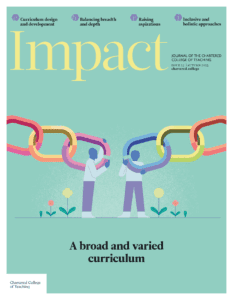Developing and implementing a knowledge-rich curriculum for the early years

MICHIEL WILS, MAXIME BULTHEEL, TIM SURMA, JASPER NIJLUNSING, CLAUDIO VANHEES AND PAUL A KIRSCHNER
THOMAS MORE UNIVERSITY OF APPLIED SCIENCES, BELGIUM
Introduction
Knowledge of the world is essential for later reading and writing skills, and even predicts maths and science outcomes (Grissmer et al., 2010). However, ‘world knowledge’ is not evenly distributed: variations in home environments are associated with differences in early developmental outcomes, which can contribute to a widening gap between children’s knowledge and learning over time (Passaretta et al., 2022). Recent studies offer promising evidence that a well-sequenced, knowledge-rich curriculum, starting in the early years, can help to lay strong foundational knowledge for all children (Chambers et al., 2016; Surma et al., 2025).
This article presents an overview of key characteristics of a knowledge-rich curriculum, before illustrating these in practice through a case study of three preschools in Antwerp, Belgium.
Key characteristics of a knowledge-rich curriculum
We conceptualise a knowledge-rich curriculum as a plan for learning that focuses on powerful, structured knowledge that builds over time to give students the foundational knowledge required to make sense of the world. It adheres to three overarching principles: content-richness, coherence and clarity (Surma et al., 2025).
Content-richness refers to content leading the curriculum, emphasising broad, worldly knowledge. There is a focus on depth by embedding complex skills within curriculum design, creating interaction between knowledge and skills, which is necessary to deepen knowledge (Surma et al., 2025).
Coherence refers to: (a) logical progression over time, where previously learned content is the foundation for future learning (vertical coherence); and (b) relations being understood across disciplines (horizontal coherence) (Thijs and van den Akker, 2009).
Clarity concerns formulating curriculum goals so that discrepancies between what is intended and what is actually learned are reduced (Surma et al., 2025).
This is in contrast to an information-rich curriculum, emphasising large amounts of information and facts, and lacking coherence or progression, making it harder for students to form deep understanding.
From theory to practice
Based on this conceptualisation, a professional development (PD) programme was initiated in three preschools in Antwerp, aimed at: (1) strengthening effective teaching practices and agency in curriculum development; and (2) gaining insight into effective teaching practices and curriculum development in preschools.
The programme consisted of two phases. In phase one, all teachers in the participating schools followed an online course on effective instruction in early language and pre-reading skills. In 12 months, all participating teachers took the online course, and three teachers per school took part in 10 learning network sessions, where practices from the different schools were shared.
In phase two, the aims were: (1) raising awareness about the principles of a knowledge-rich curriculum; and (2) translating these principles into practice by developing a curriculum for the early years. Each semester, the three schools received PD sessions regarding a knowledge-rich curriculum for the entire team. Curriculum development took place during and between learning network sessions, with the same three teachers per school as in phase one. They also received extra time in their work schedules for curriculum development.
School leaders played a key role. Ensuring sustainable implementation within schools’ operations, they participated in the Exemplary Leadership Programme. Hosted by the Knowledge Hub, this nine-month blended programme included online webinars, conferences and school visits, focusing on behaviour culture, curriculum development and enactment.
Curriculum development process
Regarding content-richness, a thematic approach was used, with themes spanning from five to six weeks and comprising history, geography, science and technique, and arts.
Vertical coherence was considered during development. Preschool in Flanders (ages two-and-a-half to six) comprises three grades, so by working backwards in thematic progression lines from the last grade to the first, coherent vertical learning progression was developed both in and across the grades. For example, in the first thematic progression line – covering concepts linked to Antwerp – a theme for the third grade of preschool explored the Golden Age of Antwerp, introducing concepts such as guildhalls and traditional crafts. However, to grasp the concept of traditional crafts, it is necessary for children to first understand contemporary professions, which were therefore introduced in the second grade.
The same vertical approach was followed for developing the second thematic progression line. Here, horizontal coherence was also considered by establishing connections across different themes within and across years. For instance, to grasp the importance of the River Scheldt for Antwerp during its Golden Age, it is helpful to tackle the concept of a river as a living environment for different plants and animals and as a transportation route.
Clarity was respected by explicitly stating the objectives per theme and suggesting focus vocabulary (up to six related words per sub-theme).
Results
To gain insight into teacher agency in curriculum development, in-depth interviews and focus group discussions were held. From the interviews conducted at the beginning of the PD programme, we were able to outline the initial situation for the three schools.
Initially, learning content in each school was determined primarily by individual teachers. All schools stated that they mainly selected content based on the children’s personal environment and preferences. One school mentioned that they intentionally set the content bar low, so that every child could participate. Because of the vague developmental objectives for preschool in Flanders, teachers’ choices regarding content varied widely, ranging from thematic approaches, to first selecting activities, to starting from learning objectives.
Little attention was paid to vertical coherence. One school said that specific attention was paid to learning progression in maths and languages, but also noted that no clear learning progressions were implemented within year groups and teachers determined this individually. Horizontal coherence was interpreted differently across schools. For one school, this was reflected in the way in which languages and maths were integrated into a thematic approach. Another indicated that horizontal coherence had disappeared ever since they worked with seasonal themes, which they believed offered fewer perspectives.
Changes and challenges
During follow-up interviews and focus group discussions, the teachers involved in the learning networks expressed enthusiasm, which was shared by teams who attended PD sessions.
The schools indicated that this knowledge-rich approach was rewarding but challenging, particularly when delineating the themes and attempting not to get lost in detail. By focusing on coherence, the teachers signalled that they developed more know-how on lesson content, which they felt had improved their teaching practices as well.
Although the schools considered the programme highly valuable, all reported that significantly more time was needed to complete the assignments and development work. The PD programme put additional pressure on daily operations, as the lessons of teachers participating in the learning network sessions needed to be covered. While the enthusiasm of the participating teachers was evident, collective commitment and dissemination of knowledge and skills to colleagues was a challenge. This was attributed to the limited time and resources available.
Conclusion
The aim was to strengthen effective teaching and teacher agency in the development of a knowledge-rich curriculum that is underpinned by content-richness, coherence and clarity. All participating teams experienced the programme as highly valuable. A positive impact on teacher practice and enthusiasm was reported. However, time constraints and the labour-intensive nature of curriculum development underscore the need for additional support to ensure effective integration of knowledge-rich approaches in preschools.
- Chambers B, Cheung ACK and Slavin RE (2016) Literacy and language outcomes of comprehensive and developmental-constructivist approaches to early childhood education: A systematic review. Educational Research Review 18: 88–111.
- Grissmer D, Grimm KJ, Aiyer SM et al. (2010) Fine motor skills and early comprehension of the world: Two new school readiness indicators. Developmental Psychology 46(5): 1008–1017.
- Passaretta G, Skopek J and van Huizen T (2022) Is social inequality in school-age achievement generated before or during schooling? A European perspective. European Sociological Review 38(6): 849–865.
- Surma T, Vanhees C, Wils M et al. (2025) Developing Curriculum for Deep Thinking: The Knowledge Revival. Cham: Springer.
- Thijs A and van den Akker J (2009) Curriculum in Development. Enschede: Netherlands Institute for Curriculum Development.










